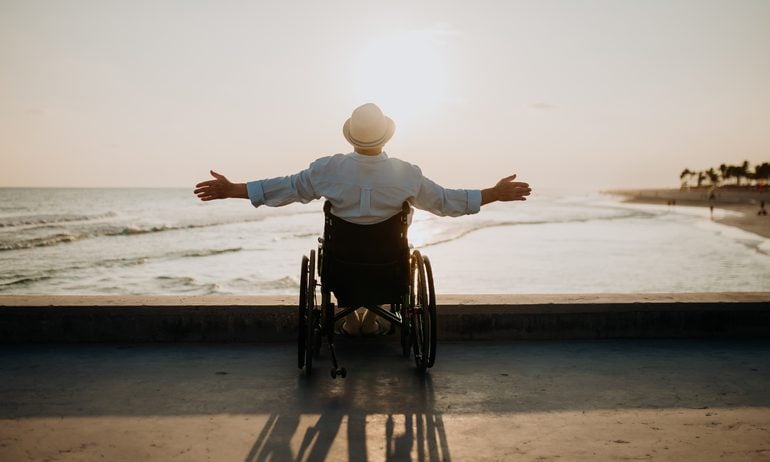Will My Disability Benefits Change at Retirement Age?
Typically, your SSDI benefits will automatically switch to Social Security retirement benefits.

Many, or all, of the products featured on this page are from our advertising partners who compensate us when you take certain actions on our website or click to take an action on their website. However, this does not influence our evaluations. Our opinions are our own. Here is a list of our partners and here's how we make money.
The investing information provided on this page is for educational purposes only. NerdWallet, Inc. does not offer advisory or brokerage services, nor does it recommend or advise investors to buy or sell particular stocks, securities or other investments.
People who qualify for Social Security Disability Insurance benefits may question what happens when they reach full retirement age. Typically, benefits don’t change — they automatically switch to Social Security retirement benefits.
Here’s how it works.
What is SSDI?
Social Security Disability Insurance, or SSDI, is government assistance available to people with a qualifying disability. Benefits may also be available to family members of people receiving SSDI benefits.
Your SSDI benefits are calculated using the same equation that Social Security uses for your benefits at your full retirement age. The average monthly benefit is $1,537 in 2024. The maximum monthly SSDI benefit is $4,018 in 2025.
Who qualifies for SSDI?
Social Security Disability Insurance benefits are pegged to Social Security — in that you must have worked at jobs covered by Social Security and must have a Social Security-defined disability.
To qualify on the job front, you must have enough work credits earned through wages or self-employment income. The amount you need changes yearly and depends on your age when your disability started.
To qualify as having a Social Security disability, you must meet these requirements:
You are not working and make less than the limit. The substantial gainful activity limit for 2025 is $1,620 per month ($2,700 if blind).
Your condition is severe — meaning it limits your ability to do work-related activities for at least a year.
Your condition is on Social Security’s list of medical conditions they consider severe. (Some examples: traumatic brain injury, multiple sclerosis or cystic fibrosis.) If your condition isn’t on the list, the agency must decide whether your condition would fit the list.
You can’t do the work you did before because of your condition.
You can’t do other work because of your condition.
Certain diagnoses lead to a quicker determination of disability, including Lou Gehrig’s disease, also called amyotrophic lateral sclerosis, or ALS; pancreatic cancer; and acute leukemia.
Will your disability benefits change when you turn 65?
No, your disability benefits will continue until you hit your full Social Security retirement age, which is between 66 and 67, depending on your birth year. When you reach your full retirement age, your SSDI benefits will automatically transition to Social Security retirement benefits.
If you’ve been on SSDI for at least 24 months, you likely already have Medicare.
However, if you start collecting a pension from a job in which you didn’t pay taxes to Social Security, your SSDI amount may decrease. For instance, this would include a pension from the federal civil service system or a nonprofit.
Do you have to contact anyone to switch from SSDI to Social Security?
No, your SSDI benefits will automatically be switched to Social Security retirement benefits when you reach full Social Security retirement age.
If you’re getting a reduced widow or widower’s SSDI benefit, however, you’ll need to contact Social Security when you hit your full retirement age so your benefits can be adjusted accordingly.
» MORE: Is disability income taxable?
Should you claim early Social Security benefits?
Your SSDI benefit amount is calculated to be the same as what you’d receive at your full Social Security retirement age. So if you claim Social Security retirement benefits at age 62, you’ll receive a reduced amount. However, if you qualify for SSDI, that benefit amount will be higher than taking early Social Security until you reach full retirement age.
Can you collect SSI and Social Security disability or retirement benefits?
Supplemental Security Income, or SSI, provides financial assistance to qualified individuals with limited incomes. Generally, individuals receiving SSI are 65 or older, blind or have a Social Security-defined disability.
You can qualify for SSI and SSDI benefits at the same time, although your overall benefits will be reduced accordingly. If you qualify for SSI, your benefits start the first full month after the date you filed your claim. If you qualify for SSDI, your benefits start the sixth full month of disability.
You may also be eligible for SSI and Social Security retirement benefits at the same time — and the application is the same for both. However, if you’re eligible for both benefits, your SSI benefits may be reduced based on your Social Security retirement benefits.


